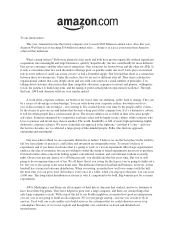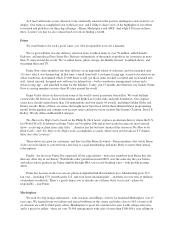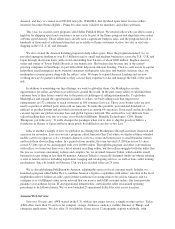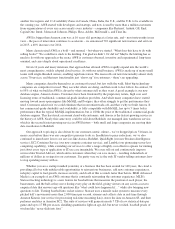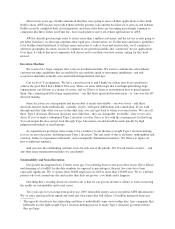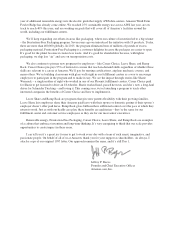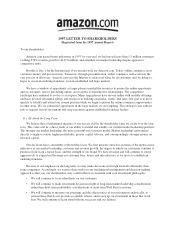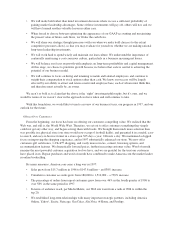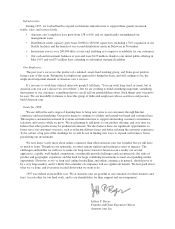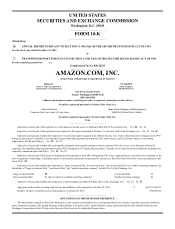Amazon.com 2015 Annual Report Download - page 2
Download and view the complete annual report
Please find page 2 of the 2015 Amazon.com annual report below. You can navigate through the pages in the report by either clicking on the pages listed below, or by using the keyword search tool below to find specific information within the annual report.
To our shareowners:
This year, Amazon became the fastest company ever to reach $100 billion in annual sales. Also this year,
Amazon Web Services is reaching $10 billion in annual sales … doing so at a pace even faster than Amazon
achieved that milestone.
What’s going on here? Both were planted as tiny seeds and both have grown organically without significant
acquisitions into meaningful and large businesses, quickly. Superficially, the two could hardly be more different.
One serves consumers and the other serves enterprises. One is famous for brown boxes and the other for APIs. Is
it only a coincidence that two such dissimilar offerings grew so quickly under one roof? Luck plays an outsized
role in every endeavor, and I can assure you we’ve had a bountiful supply. But beyond that, there is a connection
between these two businesses. Under the surface, the two are not so different after all. They share a distinctive
organizational culture that cares deeply about and acts with conviction on a small number of principles. I’m
talking about customer obsession rather than competitor obsession, eagerness to invent and pioneer, willingness
to fail, the patience to think long-term, and the taking of professional pride in operational excellence. Through
that lens, AWS and Amazon retail are very similar indeed.
A word about corporate cultures: for better or for worse, they are enduring, stable, hard to change. They can
be a source of advantage or disadvantage. You can write down your corporate culture, but when you do so,
you’re discovering it, uncovering it – not creating it. It is created slowly over time by the people and by events –
by the stories of past success and failure that become a deep part of the company lore. If it’s a distinctive culture,
it will fit certain people like a custom-made glove. The reason cultures are so stable in time is because people
self-select. Someone energized by competitive zeal may select and be happy in one culture, while someone who
loves to pioneer and invent may choose another. The world, thankfully, is full of many high-performing, highly
distinctive corporate cultures. We never claim that our approach is the right one – just that it’s ours – and over
the last two decades, we’ve collected a large group of like-minded people. Folks who find our approach
energizing and meaningful.
One area where I think we are especially distinctive is failure. I believe we are the best place in the world to
fail (we have plenty of practice!), and failure and invention are inseparable twins. To invent you have to
experiment, and if you know in advance that it’s going to work, it’s not an experiment. Most large organizations
embrace the idea of invention, but are not willing to suffer the string of failed experiments necessary to get there.
Outsized returns often come from betting against conventional wisdom, and conventional wisdom is usually
right. Given a ten percent chance of a 100 times payoff, you should take that bet every time. But you’re still
going to be wrong nine times out of ten. We all know that if you swing for the fences, you’re going to strike out a
lot, but you’re also going to hit some home runs. The difference between baseball and business, however, is that
baseball has a truncated outcome distribution. When you swing, no matter how well you connect with the ball,
the most runs you can get is four. In business, every once in a while, when you step up to the plate, you can score
1,000 runs. This long-tailed distribution of returns is why it’s important to be bold. Big winners pay for so many
experiments.
AWS, Marketplace and Prime are all examples of bold bets at Amazon that worked, and we’re fortunate to
have those three big pillars. They have helped us grow into a large company, and there are certain things that
only large companies can do. With a tip of the hat to our Seattle neighbors, no matter how good an entrepreneur
you are, you’re not going to build an all-composite 787 in your garage startup – not one you’d want to fly in
anyway. Used well, our scale enables us to build services for customers that we could otherwise never even
contemplate. But also, if we’re not vigilant and thoughtful, size could slow us down and diminish our
inventiveness.


